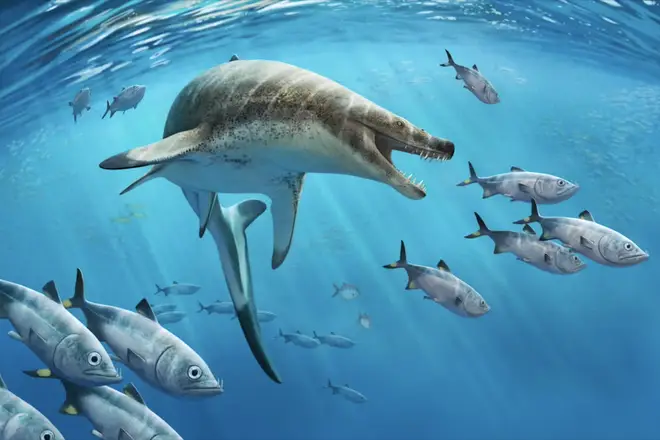
Ian Payne 4am - 7am
5 March 2024, 16:40 | Updated: 5 March 2024, 17:18

A "nightmarish" sea lizard has been discovered by scientists that would have dominated the oceans 66 million years ago.
Khinjaria acuta would have lived alongside land-based dinosaurs like Tyrannosaurus Rex.
Scientists discovered the fossil at an uncovered phosphate mine in the southeast of Casablanca, Morocco.
The sea lizard would have measured between seven and eight metres, a similar measurement to an orca.
As well as its length, the Khinjaria had strong jaws with an array of dagger-like teeth to clamp down on prey, and an elongated skull and jaw muscle structure, suggesting it had "a terrible biting force".
These features would have given the creature a "nightmarish appearance", according to researchers.
The sea lizard belongs to the mosasaurs, a family of giant marine lizards, which are the ancestors of the modern-day Komodo dragon and anaconda.
According to scientists, these marine creatures were apex predators, creatures at the top of the food chain, and swam alongside other mosasaurs such as "saw-toothed" Xenodens and "star-toothed" Stelladen.

The region's warm currents and nutrient-dense waters could have provided food for large numbers of marine wildlife, supporting many apex predators such as Khinjaria.
Dr Nick Longrich, from the Department of Life Sciences and the Milner Centre for Evolution at the University of Bath, who led the study, said: "What's remarkable here is the sheer diversity of top predators.
"We have multiple species growing larger than a great white shark, and they’re top predators, but they all have different teeth, suggesting they’re hunting in different ways.
"Some mosasaurs had teeth to pierce prey, others to cut, tear, or crush. Now we have Khinjaria, with a short face full of huge, dagger-shaped teeth.
"This is one of the most diverse marine faunas seen anywhere, at any time in history, and it existed just before the marine reptiles and the dinosaurs went extinct," he added.

The study, published in the journal Cretaceous Research, is based on skull and skeletal analysis of the creature's remains.
Mosasaurs became extinct around the same time as the dinosaurs, in an event thought to be related to the aftermath of an asteroid impact in the Yucatan Peninsula in Mexico.
When these predators disappeared, whales and seals then dominated the oceans, while swordfish and tuna started to appear, according to researchers.
There are only a few large apex predators in modern marine food chains, such as orcas, white sharks and leopard seals.
Dr Longrich commented on how much the ecosystem has changed since prehistoric times.
He said: "There seems to have been a huge change in the ecosystem structure in the past 66 million years.
"This incredible diversity of top predators in the Late Cretaceous is unusual, and we don’t see that in modern marine communities."
Dr Longrich added: "Whether there's something about marine reptiles that caused the ecosystem to be different, or the prey, or perhaps the environment, we don’t know.
"But this was an incredibly dangerous time to be a fish, a sea turtle, or even a marine reptile."